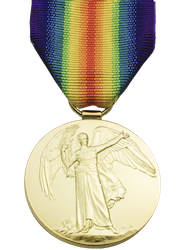|
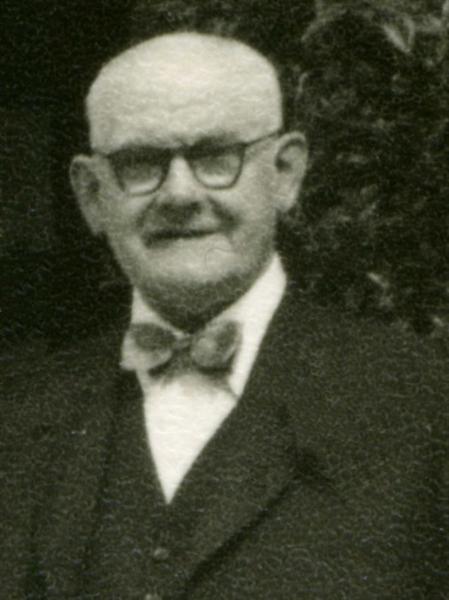 Thurston
was born on the 12th of January 1890 at the family home of 42 Oxford Street in
the Higher Audley area of Blackburn, Lancashire. He was the ninth of eleven children born to John Jackson,
a Cotton Carder, and his wife Mary
Ann (nee Alston). He was christened a fortnight later at the nearby church of St
Matthew on the 26th of January. Thurston
was born on the 12th of January 1890 at the family home of 42 Oxford Street in
the Higher Audley area of Blackburn, Lancashire. He was the ninth of eleven children born to John Jackson,
a Cotton Carder, and his wife Mary
Ann (nee Alston). He was christened a fortnight later at the nearby church of St
Matthew on the 26th of January.
When the 1891 census was taken on the 5th April, Thurston was recorded as an
infant living with his parents and siblings at 42, Oxford Street.
On the 13th of February 1893, at the tender age of 3 years, Thurston was
admiited to the Infants Department of Maudsley Street School. Interestingly, in
the admission register for that year, it appears his father may have lied about
his son's age, as Thurston's date of birth is recorded as 20th June 1889. There
is also a remark that he left, so perhaps he didn't get away with it. He was
readmitted the following year on the 13th of March 1894, this time his date
of birth is recorded as the 23rd June 1889, presumably to hide the previous lie.
In the March 1901 census, aged 11, Thurston was still at 42 Oxford Street
with his parents and nine siblings. However, by the time the April 1911 census
was taken, he had begun work as a Cotton Weaver but was still living with his
parents at the same address along with his youngest brother James.
Thurston married Sarah
Howson on the 3rd of April 1915 at St Matthew's Church in Blackburn.
The occupation of both was recorded as 'Weavers'. The marriage was witnessed by
Sarah's eldest brother John Edward Howson and Thurston's sister Celia
Haydock. Soon after their marriage the couple moved into the 'two-up, two-down' house at
31 Oxford Street, which was just down and across the street from his
parents at number 42. They stayed at this address for the rest of their lives.
On the 11th December 1915, a month before his 26th
birthday and just over 8 months after he had married, Thurston enlisted in the Army
under the Derby Scheme(1). During 1916 he
underwent training as a Driver(2) with the Royal Field Artillery regiment and was
held in Army reserve until he was mobilized on the 3rd February 1917. He
travelled
to Aldershot on the 8th April and was posted, on the 9th June, to the 117th
(Howitzer)
Brigade RFA. The 117 Brigade were sent to Egypt, arriving in Alexandria on the
5th of July, to join the 74th (Yeomanry)Division. During his time in the
Middle-East, Thurston would have participated in several actions, such as; The
Third Battle of Gaza (including the capture of Beersheba and Sheria), the
capture and defence of Jerusalem and The Battle of Tell'Asur. In March 1918, the
74th Division were told to prepare for a move to France. The first units landed
at Marseilles on the 7th of May and the Division was fully established near
Abbeville by the 18th May. After training for unfamiliar operations, such as gas
defence, the units moved to Doullens ready to take over a sector of the front
line on the 14th July.
| Unfortunately, although
really the word 'luckily' would be more apt, Thurston was sent to a
field hospital on the 1st June, with a fracture of the large bone
(radius) in his right forearm and was sent back to England. Whilst
Thurston was back in England recovering from his injury, his regiment
was invloved in some major battles on the Somme. On the 8th October 1918
he was discharged from the Army as 'no longer physically fit for war
service' and awarded the Silver War Badge. By wearing the badge, a
man not in uniform could show that he had 'done his bit' but was no
longer physically able to continue. He did receive the Victory Medal and
the British War Medal. |
|
Thurston's army service records, which can be viewed via
the tab below, are in quite a poor condition. Around two-thirds of WW1 service
records were lost when the War Office repository in London was bombed in
September 1940. Thurston's records were damaged but thankfully were preserved.
His wife Sarah gave birth to their first child, a boy they named Thurston, on the 27th of
January 1918. Sadly the baby died after seven weeks - no baptism record has been
found. The death of the baby was recorded in Thurston's Army Service Records
(Page 6). It's unlikely that he was given compassionate leave, as he was serving
in the Middle-East at that time, so wouldn't have arrived home in time for the
burial, which took place on the 21st of March at Blackburn Cemetery, Whalley New
Road.
Sarah and Thurston had three more children, all of whom survived.
Celia Jackson 1919-2011
John Jackson 1923-1980
Irene Jackson 1936-2001
When the National Register was made in September 1939, Thurston, his wife Sarah and children Celia,
John and Irene, were living at 31 Oxford Street in Blackburn. Thurston was
unemployed. However, with the outbreak of World War Two, he was soon employed
making munitions at the newly built Royal Ordnance Factory at Blackamoor.
Thurston was known to his family and friends as 'Tot'. He had various occupations; as
a Cotton Weaver, a Soldier, a
Booky's Runner and later as a Nightwatchman at the Palatine Dairy in Blackburn.
One night at the Dairy, Thurston encountered a gang of thieves breaking in and was bashed on
the head by one of them - he needed several stitches. Tot was a daily visitor to
the Brunswick Pub on the corner of Higher Audley Street and Audley Range. It was
from here that he 'ran' horse-racing bets to a Bookmaker in Cort Street (behind
the Town Hall). He regularly helped his clients celebrate their wins and would
come home very drunk (but happy).
He died in Blackburn Royal Infirmary on the 1st of July 1965
at the age of 75
and was buried on the 6th of July in Pleasington Cemetery on the outskirts of Blackburn.
Notes
1. The Derby Scheme
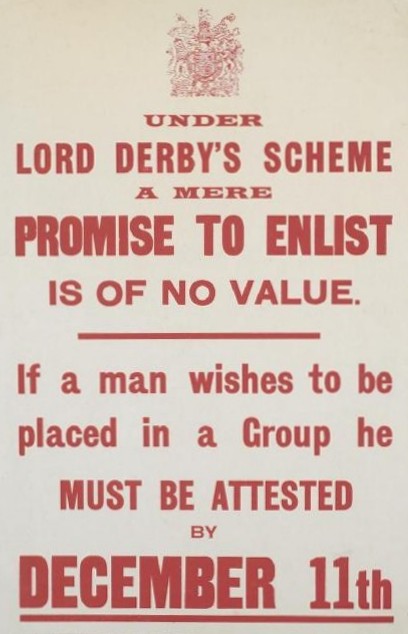 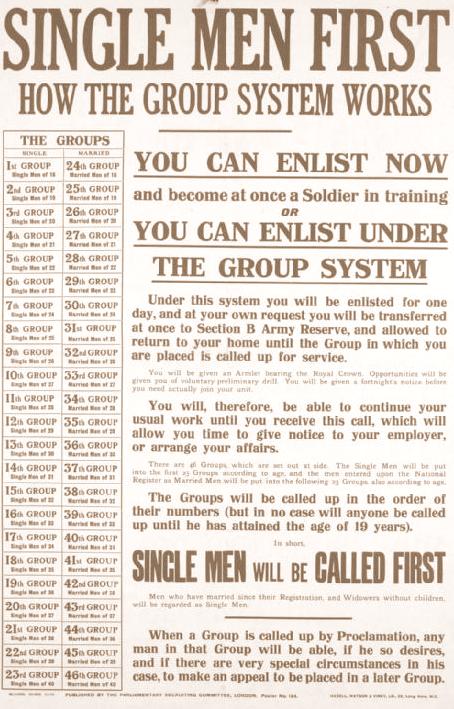 On the 11th of October 1915 Lord Derby was
appointed Director-General of Recruiting. He
brought forward a programme five days later, often called the Derby Scheme
although its official title was the Group Scheme, for raising the numbers. Men
aged 18 to 40 were sent cards informing them that they could continue to enlist
voluntarily or attest with an obligation to come if called up later on. The War
Office notified the public that voluntary enlistment would soon cease and that
the last day of registration would be the 15th December 1915. Men who attested
under the Derby Scheme, who were accepted for service and chose to defer it were
classified as being in "Class A". Those who agreed to immediate service were
"Class B". The Class A men were paid a day's army pay for the day they attested;
were given a grey armband with a red crown as a sign that they had so
volunteered; were officially transferred into Section B Army Reserve; and were
sent back to their homes and jobs until they were called up. The scheme,
however, was seen as a failure. Although 215,000 men enlisted while the scheme
was on and another 2,185,000 attested for deferred enlistment, 38% of single men
and 54% of marrieds who were not in "starred" jobs had still avoided this form
of recruitment. Their reticence did much to hasten a move to full conscription.
Voluntary attestation reopened on 10 January 1916, while the government
considered the position. Furthermore, recruits were not necessarily posted to
their local regiments and rarely had a say in the regiment to which they were
assigned. On the 11th of October 1915 Lord Derby was
appointed Director-General of Recruiting. He
brought forward a programme five days later, often called the Derby Scheme
although its official title was the Group Scheme, for raising the numbers. Men
aged 18 to 40 were sent cards informing them that they could continue to enlist
voluntarily or attest with an obligation to come if called up later on. The War
Office notified the public that voluntary enlistment would soon cease and that
the last day of registration would be the 15th December 1915. Men who attested
under the Derby Scheme, who were accepted for service and chose to defer it were
classified as being in "Class A". Those who agreed to immediate service were
"Class B". The Class A men were paid a day's army pay for the day they attested;
were given a grey armband with a red crown as a sign that they had so
volunteered; were officially transferred into Section B Army Reserve; and were
sent back to their homes and jobs until they were called up. The scheme,
however, was seen as a failure. Although 215,000 men enlisted while the scheme
was on and another 2,185,000 attested for deferred enlistment, 38% of single men
and 54% of marrieds who were not in "starred" jobs had still avoided this form
of recruitment. Their reticence did much to hasten a move to full conscription.
Voluntary attestation reopened on 10 January 1916, while the government
considered the position. Furthermore, recruits were not necessarily posted to
their local regiments and rarely had a say in the regiment to which they were
assigned.
2.
A Driver with the Royal Field Artillery during WW1 'drove' the horses towing a
howitzer or ammunition wagon, not a vehicle with an engine. Each Driver was
responsible for a pair of horses. A gun team usually comprised six horses, the
lead pair was usually ridden by a Sergeant, the next pair by a Corporal and the
rear pair by a Driver (Private) - this rear pair of horses were usually the
strongest and called the 'Wheelers', it was their strength that initially moved
the gun carriage, they were also the brakes of the team. During WW1, Drivers
were paid 1s-2d a day. |
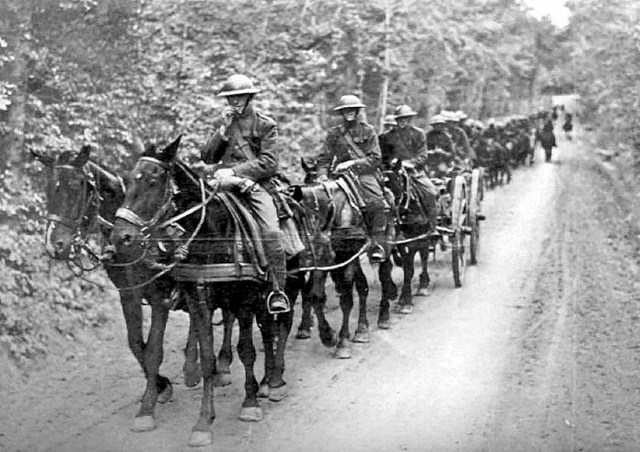 |
|

 On the 11th of October 1915 Lord Derby was
appointed Director-General of Recruiting. He
brought forward a programme five days later, often called the Derby Scheme
although its official title was the Group Scheme, for raising the numbers. Men
aged 18 to 40 were sent cards informing them that they could continue to enlist
voluntarily or attest with an obligation to come if called up later on. The War
Office notified the public that voluntary enlistment would soon cease and that
the last day of registration would be the 15th December 1915. Men who attested
under the Derby Scheme, who were accepted for service and chose to defer it were
classified as being in "Class A". Those who agreed to immediate service were
"Class B". The Class A men were paid a day's army pay for the day they attested;
were given a grey armband with a red crown as a sign that they had so
volunteered; were officially transferred into Section B Army Reserve; and were
sent back to their homes and jobs until they were called up. The scheme,
however, was seen as a failure. Although 215,000 men enlisted while the scheme
was on and another 2,185,000 attested for deferred enlistment, 38% of single men
and 54% of marrieds who were not in "starred" jobs had still avoided this form
of recruitment. Their reticence did much to hasten a move to full conscription.
Voluntary attestation reopened on 10 January 1916, while the government
considered the position. Furthermore, recruits were not necessarily posted to
their local regiments and rarely had a say in the regiment to which they were
assigned.
On the 11th of October 1915 Lord Derby was
appointed Director-General of Recruiting. He
brought forward a programme five days later, often called the Derby Scheme
although its official title was the Group Scheme, for raising the numbers. Men
aged 18 to 40 were sent cards informing them that they could continue to enlist
voluntarily or attest with an obligation to come if called up later on. The War
Office notified the public that voluntary enlistment would soon cease and that
the last day of registration would be the 15th December 1915. Men who attested
under the Derby Scheme, who were accepted for service and chose to defer it were
classified as being in "Class A". Those who agreed to immediate service were
"Class B". The Class A men were paid a day's army pay for the day they attested;
were given a grey armband with a red crown as a sign that they had so
volunteered; were officially transferred into Section B Army Reserve; and were
sent back to their homes and jobs until they were called up. The scheme,
however, was seen as a failure. Although 215,000 men enlisted while the scheme
was on and another 2,185,000 attested for deferred enlistment, 38% of single men
and 54% of marrieds who were not in "starred" jobs had still avoided this form
of recruitment. Their reticence did much to hasten a move to full conscription.
Voluntary attestation reopened on 10 January 1916, while the government
considered the position. Furthermore, recruits were not necessarily posted to
their local regiments and rarely had a say in the regiment to which they were
assigned. Thurston
was born on the 12th of January 1890 at the family home of 42 Oxford Street in
the Higher Audley area of Blackburn, Lancashire. He was the ninth of eleven children born to John Jackson,
a Cotton Carder, and his wife Mary
Ann (nee Alston). He was christened a fortnight later at the nearby church of St
Matthew on the 26th of January.
Thurston
was born on the 12th of January 1890 at the family home of 42 Oxford Street in
the Higher Audley area of Blackburn, Lancashire. He was the ninth of eleven children born to John Jackson,
a Cotton Carder, and his wife Mary
Ann (nee Alston). He was christened a fortnight later at the nearby church of St
Matthew on the 26th of January. 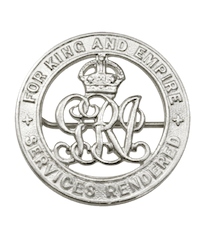
.png)
